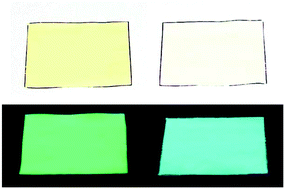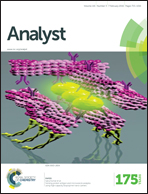Highly CO2 sensitive extruded fluorescent plastic indicator film based on HPTS†
Abstract
Highly-sensitive optical fluorescent extruded plastic films are reported for the detection of gaseous and dissolved CO2. The pH-sensitive fluorescent dye used is 8-hydroxypyrene-1,3,6-trisulfonic acid trisodium salt (HPTS, PTS−) coated on the surface of hydrophilic fumed silica and the base is tetrabutylammonium hydroxide (TBAH). The above components are used to create an HPTS pigment (i.e. HPTS/SiO2/TBAH) with a high CO2 sensitivity (%CO2 (S = 1/2) = 0.16%) and fast 50% response (t50↓) = 2 s and recovery (t50↑) = 5 s times. Highly CO2-sensitive plastic films are then fabricated, via the extrusion of the HPTS pigment powder in low-density polyethylene (LDPE). As with the HPTS-pigment, the luminescence intensity (at 515 nm) and absorbance (at 475 nm) of the HPTS plastic film decreases as the %CO2 in the ambient gas phase increases. The HPTS plastic film exhibits a high CO2 sensitivity, %CO2 (S = 1/2), of 0.29%, but a response time <2 min and recovery time <40 min, which is slower than that of the HPTS pigment. The HPTS plastic film is very stable under ambient conditions, (with a shelf life >six month when stored in the dark but under otherwise ambient conditions). Moreover, the HPTS–LDPE film is stable in water, salt solution and even in acid (pH = 2), and in each of these media it can be used to detect dissolved CO2.

- This article is part of the themed collection: Celebrating our 2019 Prize and Award winners

 Please wait while we load your content...
Please wait while we load your content...